
VOL. 32, No. 2 2017
Twice exceptional learners are intellectually or creatively gifted yet also experience one or more learning difficulties. These students face a unique set of challenges in educational settings. Recommended strategies for accommodating twice exceptional learners focus on – among other things – (1) providing freedom and variety, so that students can engage with learning in a way that interests them, plays to their strengths, and compensates for their learning difficulties; (2) allowing students to engage with simulated and real-world problems; and (3) providing an adaptable environment that is pleasing to students, and sensitive to any specific needs they may have as a result of learning difficulties. In this article, we show how the video game Minecraft can facilitate learning environments that embody these recommendations. We describe in detail a variety of specific techniques for implementing such environments, including contextualised learning artefacts and puzzle rooms. We then demonstrate examples of learning environments that we have previously implemented using these techniques. These environments are currently being used in an empirical evaluation, as part of a larger project investigating the effectiveness of Minecraft as an educational resource for twice exceptional students.
Bien qu’ils éprouvent une ou plusieurs difficultés d’apprentissage, les étudiants doublement exceptionnels (c’est-dire ayant des besoins éducatifs spéciaux) sont doués intellectuellement ou au niveau de la créativité. Ces étudiants font face à un ensemble unique de défis en contexte éducatif. Les stratégies recommandées pour accommoder les apprenants doublement exceptionnels sont, en autres, centrés sur (1) proposer de la liberté et de la variété afin que les étudiants puissent s’engager dans leur apprentissage de la manière qui les intéresse, qui fonctionne avec leurs forces et compense leurs difficultés ; (2) permettre aux étudiants de s’engager dans des problèmes réels ou simulés; et (3) offrir un environnement adaptable qui plait aux étudiants et qui est sensible à tout besoin particulier qu’ils peuvent avoir en fonction de leurs difficultés d’apprentissage. Dans cet article, nous montrons comment le jeu vidéo Minecraft peut faciliter les environnements d’apprentissage qui intègrent ces recommandations. Nous décrivons en détail une variété de techniques spécifiques pour implémenter de tels environnements, y compris des artefacts d’apprentissage contextualisés et de casse-tête. Nous montrons ensuite des exemples d’environnements d’apprentissage que nous avons précédemment implémentés en utilisant ces techniques. Ces environnements font en ce moment l’objet d’une évaluation empirique, en tant que partie d’un plus grand projet d’enquête sur l’efficacité de Minecraft comme ressource éducative pour les étudiants doublement exceptionnels.

This work is licensed under a Creative Commons Attribution 3.0 Unported License.
Twice exceptional (2e) learners are those who are intellectually gifted and experience some form of learning difficulty. They face a variety of unique challenges in education, and often are under-provided for in traditional school settings. As such, novel approaches to the education of 2e learners are required. Here, we show how the popular video game Minecraft may be used to facilitate such approaches. We describe 2e learners, identify specific challenges they face, and explain the appropriate characteristics of an inclusive learning environment that may help to overcome these challenges. Next, by focusing specifically on Minecraft, we show how video games possess many of these characteristics. Finally, we describe the design and development of novel learning environments in Minecraft, created specifically to cater for the needs of 2e learners.
Giftedness is difficult to define precisely, as its traits are often consistent with hegemonic academic values, which may vary with the evolution of, for example, pedagogical theory, assessment styles, and an understanding of what it means to fulfil one’s potential. (Renzulli, 2005; Plucker & Barab, 2005). Broadly speaking, however, gifted students are those who may display outstanding ability in some area of human production, such as intellectual or creative ability. The broadness of the concept of giftedness is evident in the U.S. Department of Education definition:
[Gifted] children and youth exhibit high capability in intellectual, creative, and/or artistic areas, possess an unusual leadership capacity, or excel in specific academic fields. They require services or activities not ordinarily provided by the schools. Outstanding talents are present in children and youth from all cultural groups, across all economic strata, and in all areas of human endeavor. (Ross, 1993, p. 26)
A US National Commission on Twice Exceptional Students (incorporating researchers, educators, and policymakers) developed the following definition of 2e learners, which incorporates a similarly broad conception of giftedness:
Twice-exceptional learners are students who demonstrate the potential for high achievement or creative productivity in one or more domains such as math, science, technology, the social arts, the visual, spatial, or performing arts or other areas of human productivity AND who manifest one or more disabilities as defined by federal or state eligibility criteria. These disabilities include specific learning disabilities; speech and language disorders; emotional/behavioral disorders; physical disabilities; Autism Spectrum Disorders (ASD); or other health impairments, such as Attention Deficit/Hyperactivity Disorder (ADHD). These disabilities and high abilities combine to produce a unique population of students who may fail to demonstrate either high academic performance or specific disabilities. Their gifts may mask their disabilities and their disabilities may mask their gifts. (Reis, Baum & Burke, 2014, p. 222)
Foley Nicpon, Allmon, Sieck & Stinson (2011) note that, while all but one of the disabilities identified in the Individuals with Disabilities Education Improvement Act (IDEA; 2004) could exist in a gifted student, most research focuses on students with ASD, ADHD, and specific learning disabilities (SLD), such as dyslexia and dyspraxia.
Several challenges exist in the education of 2e students. As noted in the definition provided by Reis et al. (2014) it can be difficult to even identify such learners, as their giftedness may mask or compensate for their learning difficulties; alternatively, their learning difficulties may mask their giftedness (see also King, 2005; McCoach, Kehle, Bray & Siegle, 2001). For example, the use of IQ tests to identify gifted students may mean that 2e students are not recognised as gifted because their disability lowers their average scores even though they have potential high ability in certain areas (Silverman, 2009). Alternatively, complex compensatory behaviours evidenced in 2e students – which may prevent their disability being identified – may in fact be characteristic of the gifted element of their experience (Silverman, 2009). This lack of identification will obviously lead to lack of appropriate curricular interventions (Nielson, 2002). Even when 2e students are identified as such, they may primarily receive support for the learning difficulty; the gifted component may not be addressed to the same extent, even though the two may be linked. For example, in reviewing 315 cumulative education folders of 2e students, Nielson (2002) found twice as many references to the students’ disability characteristics as to their giftedness-related characteristics. In addition, asynchronous development of academic ability versus the social and emotional spheres (Silverman, 2009) and social and emotional issues, such as anxiety, disruptive behaviour, poor relationships with peers and teachers, and unrealistic self-expectations, may all present challenges to 2e learners and to their teachers (Foley Nicpon et al., 2011).
It is therefore imperative to develop contexts in which the 2e student can thrive. Nielson (2002) recommends a variety of strategies which may help 2e students to learn more effectively, in terms of enhancing giftedness, providing social and emotional support, compensating for problem areas, and managing behaviour. Among these recommendations, we now pick out several themes that are particularly relevant to the work we describe in this article. Firstly, it is important to provide freedom and variety to 2e students, by accommodating multiple learning styles, allowing students to pursue projects that motivate them, allowing students to explore areas of particular interest in greater depth, and providing assignments that can be personalised to allow 2e students to exhibit their strengths. Secondly, Nielson suggests that 2e students should be given the opportunity to engage critically and creatively with problem-based learning environments, often modelled on real-world problems but using sophisticated learning techniques, such as simulations. Thirdly, 2e students should be supported through the provision of enjoyable, calming situations, and emotionally safe environments, and by the teacher being aware of the students’ frustration levels.
The educational potential of video games is now widely recognised by researchers and practitioners in a variety of fields. Gee (2007) identifies 36 learning principles found in video games. Importantly, many of these clearly coordinate with the three themes we identified in Nielson’s (2002) recommendations. Firstly, freedom and variety is found in the fact that video games allow players to progress via multiple routes, experiment and discover things for themselves, and learn through probing and reflecting upon the game world. Secondly, video games are often essentially simulations of real (or fantasy) worlds, in which the player must actively and critically engage to solve problems. Thirdly, video games are enjoyable, engaging environments, which provide information and feedback just-in-time (on-demand), incremental learning, rewards and achievements, and allow the player to operate in a safe zone, or “regime of competence”, in which they are challenged, but the challenges are not perceived to be too difficult (see Gee, 2007, Appendix, for the full list of principles).
Minecraft is a 3D sandbox game (i.e., the player may explore the area freely, and is not restricted to a specific path throughout the game). The game is available on a variety of platforms, and in a variety of editions and versions, so that it may be more accurate to describe Minecraft as a family of games. Replacing an early version of Minecraft focused on education (Minecraft:Edu), the latest version of Minecraft, designed specifically to support cross-curricular game-based teaching and learning, is Minecraft: Education Edition (Mojang, 2016). Hereafter, the term Minecraft is used but it denotes Minecraft: Education Edition, unless otherwise stated. The core gameplay of Minecraft involves manipulating the 3D blocks from which the game world is created (either by breaking them up or placing them) to create various objects and structures. Blocks have different colours and/or patterns to represent different materials (e.g., rock, lava, wood). A particularly interesting feature of Minecraft is the use of procedural generation (Hendrikx, Meijer, Van Der Velden & Iosup, 2013), by which the world in which player starts the game may be generated algorithmically by software, rather than being pre-designed. This allows the game to give the appearance of an infinite number of layouts, as the number of unique layouts that can be generated in this way is so large. A variety of educational resources have already been developed in Minecraft. For example, Short (2012) reviews tools for teaching scientific concepts in Minecraft, including in Physics and Chemistry, while Bos, Wilder, Cook & O’Donnell (2014) describe techniques for teaching Mathematics in the game. Nebel, Schneider & Rey (2016) provide a more detailed review of the use of Minecraft in education and research.
At a superficial level, Minecraft can be a simple game to play but it has hidden depths for players to discover. This means students of all abilities, including gifted students, 2e students, and students with mild or moderate learning difficulties, can engage in Minecraft at some level (Zolyomi & Schmalz, 2017). Teachers deploying Minecraft as a game-based learning platform could require students to engage in a creative, build-only activity, where they have infinite resources and no fear of monsters attacking, or, for students that are capable and interested in engaging in more depth, command blocks allow the player to place a block in the world that can execute commands. As a simple example, a block can be created that, when activated, changes the time in the game world, although much more complicated commands and chains of commands can be executed in this way.
The sandbox nature of Minecraft facilitates the freedom and open-endedness that 2e students require in their education. Children may be allowed to freely explore a Minecraft world to create and discover projects that interest and engage them. This aspect of Minecraft is demonstrated by some of the incredibly ambitious projects that players have carried out in the game. For example, players have created a scale model of the Enterprise (the extremely large spaceship featured in the Star Trek series) a replica of the Swedish parliament building (Kohler, 2010), and, using command blocks, a functioning, read-write hard drive, in which one can store and retrieve binary data (Hall, 2014). This open-endedness means that teachers can also create simulations of real-world artefacts and problems which children can engage with, which was the second aspect of video games that aligns with the recommendations of Nielson (2002) for facilitating learning in 2e students. Thirdly, Minecraft features an engaging, safe, adaptable environment. For example, Stein and Walsh (1997) note that ocular dysfunction issues are commonly associated with dyslexia, and so the adaptation of font size, colour and the environment of Minecraft could prove helpful to these students. Minecraft, therefore, meets many of the criteria required in a learning environment for 2e students.
In this section, we describe in detail methodologies for creating specific learning environments in Minecraft that can meet the needs of 2e learners. We specifically focus on (1) techniques for creating contextualised, personalised learning; (2) puzzle rooms to facilitate engagement with problems; and (3) techniques to encourage computational thinking in Minecraft.
Perhaps the most useful applications of Minecraft for 2e learners stem from its sandboxed, creative environment. As noted, creating simulations of engaging, real-world problems that are personalised to students’ interests and abilities, and enable students to learn through exploration and discovery, is an important theme that can be identified among recommendations for strategies to facilitate learning in 2e students. Therefore, the ability to create almost anything in the game means that teachers can readily develop tailored learning environments for their students. Integration with the curriculum can be facilitated in several areas. For example, scientific concepts can be taught by implementing models in the game, such as the functioning hard drive discussed previously (Hall 2014; see Short (2012) – also discussed previously – for further examples of how scientific concepts can be illustrated in Minecraft). Geography can also be easily taught in the game, as Minecraft worlds are essentially simulations of natural and built environments. The Danish Geodata Agency has designed a 1:1 scale model of Denmark in Minecraft, as part of the agency’s aim to provide free access to topographic data on Denmark (“Minecraft players”, 2014). Similarly, Ordinance Survey Ireland has made Irish geospatial data available in a format that can be imported into Minecraft (“OSi and Minecraft”, 2016; see also Short (2012), who also notes that Minecraft maps can be configured from data imported from a Geographic Information System). Teaching topics such as history and urban planning by recreating buildings and settlements is also possible. In one large study, almost 450 students from across Ireland participated in a Minecraft project to recreate their town as it was in 1916, or to imagine their town as it might be in 2116. The project found that the sandbox nature of Minecraft supported the development of 21st Century skills such as reflecting, communicating, collaborating and problem-solving (Butler, Brown & Críosta, 2016).
However, it is not just scientific concepts that can be taught in Minecraft. The Minecraft world also facilitates socio-dramatic play, with the possibility for the player to create dramatic scenes and sets. In terms of language learning, where text-heavy information could prove dissuasive for the 2e student with learning difficulties such as dyslexia, or attention and engagement based issues (as are found in students with ASD and ADHD) the constantly shifting narrative which evolves in response to player interaction provides an open ended and fully differentiated framework from which to glean knowledge at a pace controlled by the student. Bintz (1993) notes that readers are often reluctant to engage with texts due to literacy and decoding issues synonymous with dyslexia. Encouraging these students to engage with creative writing is also possible through Minecraft, as students could recreate scenes from novels, create their own mythical realms, and create “story paths” by sequentially arranging scenes according to plot along a path, while learning kinaesthetically, and without having to engage with large volumes of text. Similarly, 2e students can engage with areas of the curriculum that would otherwise potentially exclude them, such as participating in Literature Circles (Daniels, 2002; Burns, 1998). In this approach – which can be thought of as a structured and more rigorous version of a book club – children take on various response roles such as connector, questioner, illustrator, summarizer, researcher, and vocabulary enricher, to demonstrate visualisation, summarisation, prediction, and comprehension skills. For the 2e student with dyslexia, dyspraxia, dysgraphia, or indeed any fine motor skill issues, this task could prove difficult. By using Minecraft to communicate meaning, these students would be able to show visualisation capabilities by creating scenes from the story, not with a pen and paper, but with an interactive virtual world, which does not require the same level of fine motor development.
As a more detailed example, we now describe how curriculum-based, contextualised teaching of history may be facilitated in Minecraft. We begin by considering the following guidelines from the National Council for Curriculum and Assessment (NCCA) on teaching history:
An essential element in historical work is the imaginative reconstruction of the past and the communication of this interpretation to others. This involves us in synthesising an account which draws on a number of sources, using imagination to reconstruct past events, and communicating our findings to others. Children should have opportunities to use as many techniques and media as possible to record and tell about their historical findings. In doing so, they can be encouraged to use the varied pieces of information and the interpretations which they have accumulated to reconstruct imaginatively an element of the past. Often, as in the making of a model of a castle or in the staging of an historic event in role playing, the process of construction or re-creation will raise further questions. In this way the communication of historical knowledge and its interpretation in a variety of ways (particularly through non-written media) will provide an added stimulus for investigation and furnish the teacher with a means of assessing the level of understanding achieved. (National Council for Curriculum and Assessment, 1999a, p. 13)
Further, we note that making a model of a Norman castle is a suggested exercise for students in the guidelines (National Council for Curriculum and Assessment, 1999a, p. 55). Interestingly, a similar exercise is suggested in the NCCA’s guidelines for teaching students with moderate general learning disabilities (National Council for Curriculum and Assessment, 2007, p. 35). The NCCA guidelines therefore allow for the construction of a non-written recreation of a castle in Minecraft as a learning exercise using the student’s imagination and historical knowledge. A teacher may conclude that this is ideal for a differentiated exercise, as some students can draw or create physical models of a castle, whereas others can create one in a virtual world. The castle should feature stone walls, wooden floor, crenellations (battlements), a water filled moat and a drawbridge. Some students may choose to build the castle in Minecraft manually – they could dig the foundations and build the walls by laying each brick individually. We estimate that a student familiar with Minecraft might expect to take 30 minutes to complete such a model.
Puzzle rooms present a further opportunity to create meaningful, contextualised learning that may be suitable for 2e students. Puzzle rooms, as we use the term in this article, are self-contained, contextualised environments, in which individuals “discover clues, solve puzzles, and accomplish tasks in one or more rooms in order to accomplish a specific goal (usually escaping from the room) in a limited amount of time” (Nicholson, 2015, p. 1). Puzzle rooms have increased in popularity as a source of entertainment over the last decade but their narrative design and logic puzzle integration means that they may have untapped educative potential for 2e learners. In the completion of such tasks, the room therefore allows players to engage lateral-thinking skills in a collaborative, sequential way, prompting the player to solve puzzles and challenges in order to gain access to another section of the game, a piece of information that will assist them later, or, ultimately, escape from the room. Through this action alone, this puzzle becomes a logical reasoning, coding, and comprehension based challenge, requiring the reader to break the puzzle into sequential pieces, and read specifically for meaning. This endeavour evokes the learning aims of the NCCA English language curriculum in terms of language acquisition and the development of cognitive ability and the capacity to clarify thinking through oral language, writing, and reading (Nation Council for Curriculum and Assessment, 1999b, 1999c). Note also that the popular video game Portal 2 (Valve, 2011), which consists of a series of puzzle rooms, has been associated with the development of problem solving (Shute, Ventura & Ke, 2015) and fluid intelligence (Foroughi, Serraino, Parasuraman, & Boehm-Davis, 2016) in adults.
In May 2017, Code Builder was released for Minecraft. Code Builder makes it possible to program virtual agents and builders with code in the Minecraft world. Using popular Visual Programming Languages (VPL) such as Scratch, Tynker, or MakeCode, a player can invoke a program by selecting chat mode in the game and typing a word or sentence. For instance, a player could write a program that responds to the words “dig here” that causes a virtual agent to appear, dig down into the virtual ground, collect any resources (such as gold or diamonds) that it found and then return them to the player. Similarly, a player could invoke a command such as “house” and have a corresponding program cause an invisible, virtual builder to construct a house around them. VPLs are often used to teach and assess Computational Thinking (CT) skills (Brennan & Resnick, 2012).
CT is not just about programming computers. Rather, it is identified as a skill that is applicable in a variety of contexts, as it essentially involves the ability to think at multiple levels of abstraction (Wing, 2006). The concepts involved (e.g., iteration, variables), practices (e.g., debugging and remixing) and perspectives (the understanding students form from learning with CT) can be accessed using portfolio analysis, interviews, and scenarios:
Assessments should involve creating and critically examining projects. Individual projects are rich, concrete, and contextualized examples that can be explored and analyzed in a variety of ways. A collection of projects makes assessment even richer, providing an opportunity to see how understanding develops over time. (Brennan & Resnick, 2012, p. 23)
Students who struggle with CT can still engage in Minecraft the traditional way, by navigating through the virtual environment and manually interacting with each block as needed. This means a student tasked with building a castle (as described previously) would have to place each block individually, and depending on the size complexity of the castle, this could take a large amount of time. However, students may also be able to use CT skills to write a program to achieve the same result; in this case they would design, develop, and debug the algorithm to build the castle rather than manually placing each block.
In this section, we present examples of a puzzle room and contextualised learning artefacts created using the methodologies outlined in the previous section. We begin with examples of contextualised learning environments.
Figure 1 shows an example castle, which was created to illustrate how the NCCA guideline projects can be realised in Minecraft.
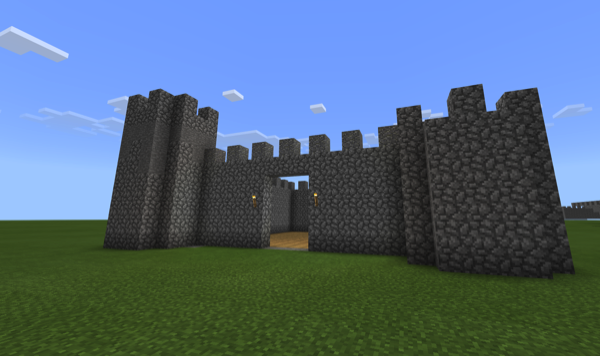
Figure 1. A castle created manually in Minecraft
Student-generated Scenes from Fiction
Figure 2 shows a student-generated scene from the Wizard of Oz, depicting the moment Dorothy discovers that her house has landed on the Wicked Witch of the East. Stairs items are used to portray the witch's feet. Figure 3 shows a student-generated scene from Charlotte’s Web: Wilbur is sitting happily in his pen in front of the barn. There are bales for Fern to sit on when she visits Wilbur. Charlotte's web can be seen over the door, and Charlotte herself is wandering around inside with the other animals.

Figure 2. A scene from the Wizard of Oz created in Minecraft
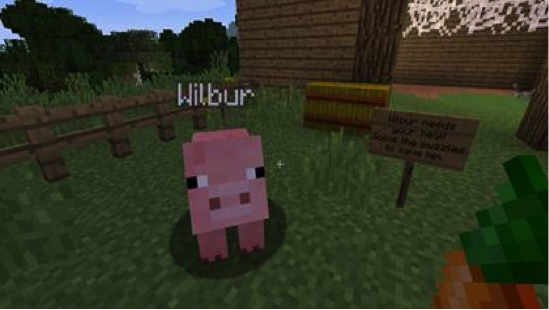
Figure 3. A scene from Charlotte’s Web created in Minecraft
Exploratory and Incidental Learning
Figure 4 and Figure 5 demonstrate an example of incidental learning occurring through exploration by students. In this example, the students were engaging with a dinosaur excavation task, yet because of the layers of stone that spawn automatically in the game, the students turned the lesson content about stratigraphy and effective dating of fossilized organisms.

Figure 4. A dinosaur excavation task created in Minecraft
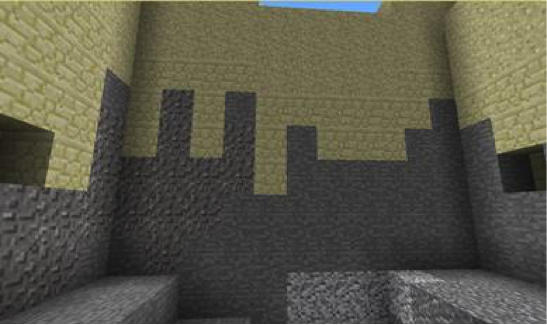
Figure 5. Automatically generated layers of stone in a Minecraft world
Figure 6 shows a castle constructed using Code Builder. A sample castle building algorithm is presented here in the VPL MakeCode (the complete code is provided in visual form, and JavaScript form, in Appendix A.
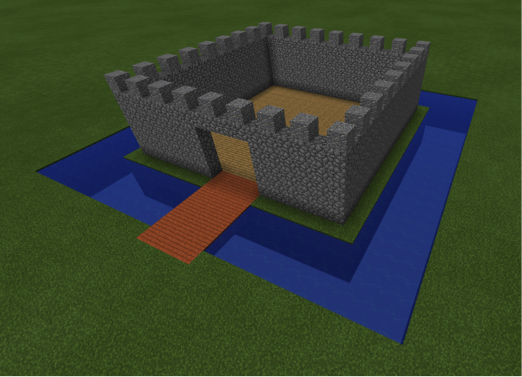
Figure 6. A castle generated automatically in Minecraft using Code Builder
The code shown in Figure 7 exhibits several Computational Thinking concepts (see also Brennan & Resnick (2012)):

Figure 7. The Minecraft Code Builder
Figure 8 shows a puzzle room based on the Harry Potter books. Interestingly, incidental learning could take place here, as the grey platforms in front of the boxes are pressure plates. These are connected via Redstone, the circuitry of Minecraft, to the dispenser boxes above. When the correct answer is achieved, and the student’s avatar jumps onto the correct pressure plate, the corresponding potion will be dispensed. In this scenario, the student will be given fire resistance via a potion. This will allow them to pass through the wall of lava, moving on to the next portion of the puzzle room. The context of this puzzle comes directly from the text, and so students are offered an alternative method of engagement with aspects of the novel.
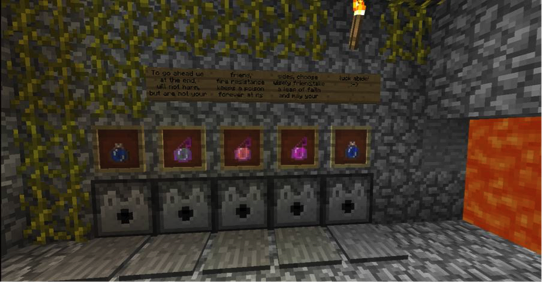
Figure 8. A puzzle room created in Minecraft
In the puzzle room shown in Figure 9, a question is being asked of the student in response to a short passage in puzzle room form. This could also be presented for increased inclusion, with recorded audio and visual representation created in Minecraft, therefore providing a multi-sensory learning experience with adaptable properties for 2e students. A similar function exists here, yet this time an Ender Pearl (an item in Minecraft which is used to teleport) is given to the player via the dispenser box. As there is no other escape from the room apart from a small window, which is not large enough to fit through, the student will have to use the Ender Pearl to escape from the room.
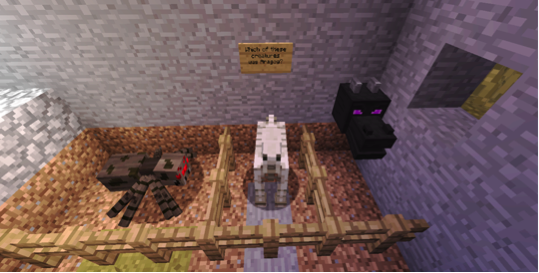
While a growing body of research is investigating the uses and effectiveness of Minecraft for typical learners, more work is required to investigate its use with twice exceptional students. The practical resources presented in this article would benefit from rigorous empirical investigation of their effectiveness. We are currently conducting a study in which the effectiveness of Minecraft in assisting twice exceptional students’ engagement with literature is being assessed. Participants are asked to engage with literature response roles from both a critical and creative perspective through Minecraft puzzle rooms, with the intention of increasing writing proficiency and confidence. This will be evaluated using student surveys, a selection of rubrics to measure mastery of skills, and recording the complexity level of the puzzle rooms created.
Bintz, W. P. (1993). Resistant readers in secondary education: Some insights and implications. Journal of Reading, 36(8), 604-615.
Brennan, K., & Resnick, M. (2012, April). New frameworks for studying and assessing the development of computational thinking. In Proceedings of the 2012 annual meeting of the American Educational Research Association, Vancouver, Canada (pp. 1-25).
Bos, B., Wilder, L., Cook, M., & O'Donnell, R. (2014). Learning mathematics through Minecraft. Teaching Children Mathematics, 21(1), 56-59. doi: 10.5951/teacchilmath.21.1.0056
Burns, B. (1998). Changing the classroom climate with literature circles. Journal of Adolescent & Adult Literacy, 42, 124-129.
Butler, D., Brown, M., & Críosta, G. M. (2016). Telling the story of MindRising: Minecraft, mindfulness and meaningful learning. International Association for Development of the Information Society.
Daniels, H. (2002). Literature circles: Voice and choice in book clubs and reading groups. (2nd ed.). Portland, ME: Stenhouse.
Foley Nicpon, M., Allmon, A., Sieck, B., & Stinson, R. D. (2011). Empirical investigation of twice-exceptionality: Where have we been and where are we going? Gifted Child Quarterly, 55(1), 3-17. doi: 10.1177/0016986210382575
Foroughi, C. K., Serraino, C., Parasuraman, R., & Boehm-Davis, D. A. (2016). Can we create a measure of fluid intelligence using Puzzle Creator within Portal 2? Intelligence, 56, 58-64. doi: 10.1016/j.intell.2016.02.011
Gee, J. P. (2007). What video games have to teach us about learning and literacy. New York: Palgrave Macmillan.
Hall, C. (2014, August 22). A guided tour of the 1 KB hard drive built inside Minecraft. Retrieved from https://www.polygon.com/2014/8/22/6057331/guided-tour-of-the-1-kb-hard-drive-built-inside-minecraft
Hendrikx, M., Meijer, S., Van Der Velden, J., & Iosup, A. (2013). Procedural content generation for games: A survey. ACM Transactions on Multimedia Computing, Communications, and Applications (TOMM), 9(1), 1. doi: 10.1145/2422956.2422957
Individuals with Disabilities Education Improvement Act of 2004, Pub. L. No. 108-446, 118 Stat. 2647 (2004).
King, E. W. (2005). Addressing the social and emotional needs of twice-exceptional students. Teaching Exceptional Children, 38(1), 16-21. doi: 10.1177/004005990503800103
Kohler, C. (2010, October 8). Constant danger fuels addictive indie game minecraft. Retrieved from https://www.wired.com/2010/10/minecraft-danger/
McCoach, D. B., Kehle, T. J., Bray, M. A., & Siegle, D. (2001). Best practices in the identification of gifted students with learning disabilities. Psychology in the Schools, 38(5), 403-411. doi: 10.1002/pits.1029
Minecraft players can now explore Denmark. (2014, April 25). Retrieved from http://www.cbc.ca/news/world/minecraft-players-can-now-explore-denmark-1.2622403
National Council for Curriculum and Assessment. (1999a). History: Social, environmental, and scientific education, teacher guidelines. Retrieved from http://www.ncca.ie/uploadedfiles/Curriculum/Primary_History_Guidelines.pdf
National Council for Curriculum and Assessment. (1999b). English Curriculum. Retrieved from https://www.curriculumonline.ie/getmedia/5b514700-e65c-46a7-a7d0-c8e05e115bf9/PSEC01a_English_Curriculum.pdf
National Council for Curriculum and Assessment. (1999c). English Language: Teacher Guidelines. Retrieved from http://www.ncca.ie/uploadedfiles/Curriculum/Eng_Gline.pdf
National Council for Curriculum and Assessment. (2007). Social, environmental, and scientific education: History, guidelines for teachers of students with moderate general learning disabilities. Retrieved from http://www.ncca.ie/uploadedfiles/P_Mod_SESEHist.pdf
Nebel, S., Schneider, S., & Rey, G. D. (2016). Mining learning and crafting scientific experiments: A literature review on the use of minecraft in education and research. Educational Technology & Society, 19(2), 355-366.
Nicholson, S. (2015). Peeking behind the locked door: A survey of escape room facilities. White Paper available online at http://scottnicholson.com/pubs/erfacwhite.pdf
Nielsen, M. E. (2002). Gifted students with learning disabilities: Recommendations for identification and programming. Exceptionality, 10(2), 93-111. doi: 10.1207/S15327035EX1002_4
Plucker, J.A., & Barab, S.A., 2005. The importance of contexts in theories of giftedness: Learning to embrace the messy joys of subjectivity. In R. J. Sternberg, J. E. Davidson (Eds.), Conceptions of giftedness (2nd ed.) (pp. 201-16).
Reis, S. M., Baum, S. M., & Burke, E. (2014). An operational definition of twice-exceptional learners: Implications and applications. Gifted Child Quarterly, 58(3), 217-230. doi: 10.1177/0016986214534976
Renzulli J. S. (2005). The three-ring conception of giftedness: A developmental model for creative productivity. In R. J. Sternberg, J. E. Davidson (Eds.), Conceptions of giftedness (2nd ed.) (pp. 246-79).
Ross, P. O. C. (1993). National excellence: A case for developing America's talent. U.S. Department of Education.
Short, D. (2012). Teaching scientific concepts using a virtual world—Minecraft. Teaching Science, the Journal of the Australian Science Teachers Association, 58(3), 55.
Shute, V.J., Ventura, M., & Ke, F. (2015). The power of play: The effects of Portal 2 and Lumosity on cognitive and noncognitive skills. Computers & education, 80, 58-67. doi:10.1016/j.compedu.2014.08.013
Silverman, L. K. (2009). The two-edged sword of compensation: How the gifted cope with learning disabilities. Gifted Education International, 25(2), 115-130.
Stein, J., & Walsh, V. (1997). To see but not to read: The magnocellular theory of dyslexia. Trends in Neurosciences, 20(4), 147-152. doi: 10.1016/S0166-2236(96)01005-3
Wing, J. M. (2006). Computational thinking. Communications of the ACM, 49(3), 33-35.
Valve. (2011). Portal 2 [Video game]. Bellevue, WA: Valve.
Zolyomi, A., & Schmalz, M. (2017, January). Mining for social skills: Minecraft in home and therapy for neurodiverse youth. In Proceedings of the 50th Hawaii International Conference on System Sciences.
Authors
Muireann O’Sullivan is a primary, second, and third level educator and researcher. She holds a B.Ed from The Institute of Education, St. Patrick’s Campus DCU, and an M.Phil from Trinity College Dublin; she is currently completing a PhD at SMARTLab, UCD. She has been designing and implementing courses for gifted students for the last decade. E-mail: osullm21@tcd.ie
Nigel Robb is a Postdoctoral Research Fellow at University College Dublin, and a Visiting Scholar at Michigan State University. His research is focused on using video games to improve the lives of neurodiverse people and other marginalised groups, through education, cognitive training, inclusive design, and social change. E-mail: nigel.robb@ucd.ie
Stephen Howell is the Academic Program Manager for Microsoft Ireland. He engages researchers, lecturers and students of all disciplines with tech talks and curriculum advice. Stephen is a PhD candidate in SMARTLab, UCD, on Computational Thinking education with kinaesthetic learning. Formerly, Stephen was a software engineer with IBM and a Computing lecturer on software development education and games based learning. E-mail: StephenHowell@outlook.com
Kevin Marshall is the Head of Education for Microsoft Ireland where he has managed the area of technology and learning for more than a decade, and has improved and shared best practices and methodologies in 21st century education across a wide variety of projects. He received his PhD from Boston College in Educational Measurement and Evaluation in 2000. He also has an MSc in Industrial Psychology from The University of HullK (1989) and is a graduate of UCD. E-mail: kevmar@microsoft.com
Lizbeth Goodman is Professor of Inclusive Design for Education and Chair of Creative Technology Innovation in the College of Engineering and Architecture at University College Dublin, where she directs SMARTlab and the Inclusive Design Research Centre of Ireland at UCD. E-mail: lizbeth.goodman@ucd.ie
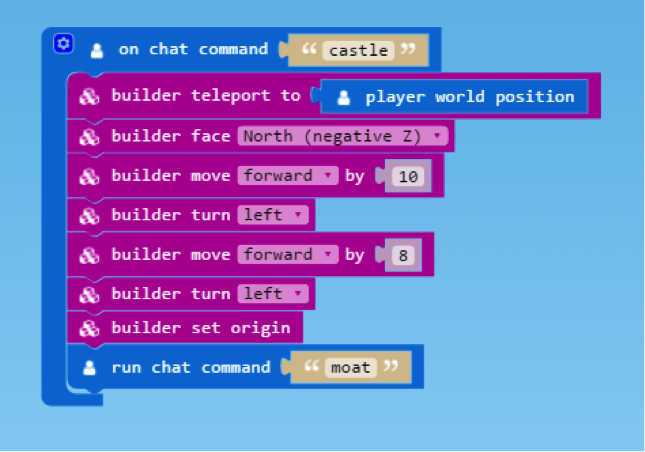
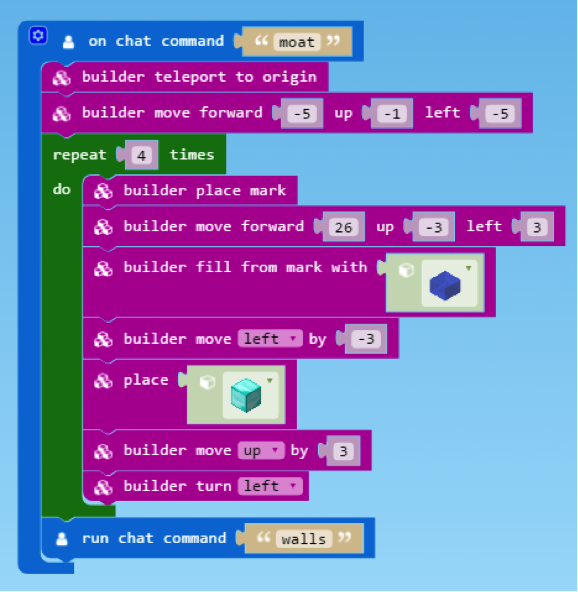


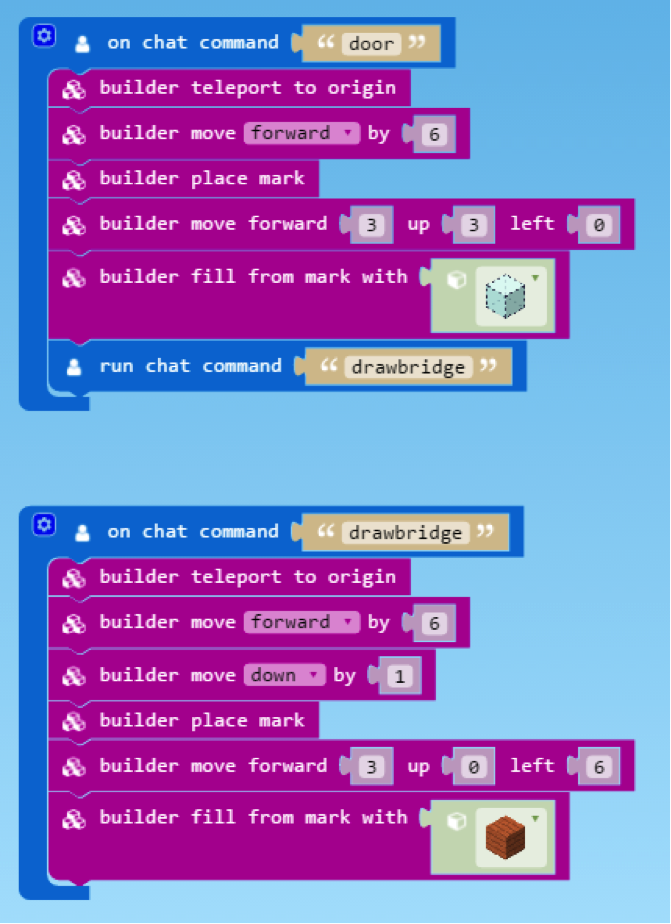
player.onChatCommand("castle", [], ({ }) => {
builder.teleportTo(player.position())
builder.face(CompassDirection.North)
builder.move(SixDirection.Forward, 10)
builder.turn(TurnDirection.Left)
builder.move(SixDirection.Forward, 8)
builder.turn(TurnDirection.Left)
builder.setOrigin()
player.runChatCommand("moat")
})
player.onChatCommand("walls", [], ({ }) => {
builder.teleportToOrigin()
for (let i = 0; i < 4; i++) {
builder.mark()
builder.move(SixDirection.Forward, 16)
builder.raiseWall(blocks.block(Block.Cobblestone), 5)
builder.turn(TurnDirection.Left)
}
builder.move(SixDirection.Up, 5)
for (let i = 0; i < 4; i++) {
for (let index = 0; index <= 15; index++) {
if (index % 2 == 0) {
builder.place(blocks.block(Block.Andesite))
}
builder.move(SixDirection.Forward, 1)
}
builder.turn(TurnDirection.Left)
}
player.runChatCommand("floor")
})
player.onChatCommand("door", [], ({ }) => {
builder.teleportToOrigin()
builder.move(SixDirection.Forward, 6)
builder.mark()
builder.shift(3, 3, 0)
builder.fill(blocks.block(Block.Air))
player.runChatCommand("drawbridge")
})
player.onChatCommand("moat", [], ({ }) => {
builder.teleportToOrigin()
builder.shift(-5, -1, -5)
for (let i = 0; i < 4; i++) {
builder.mark()
builder.shift(26, -3, 3)
builder.fill(blocks.block(Block.Water))
builder.move(SixDirection.Left, -3)
builder.place(blocks.block(Block.DiamondBlock))
builder.move(SixDirection.Up, 3)
builder.turn(TurnDirection.Left)
}
player.runChatCommand("walls")
})
player.onChatCommand("drawbridge", [], ({ }) => {
builder.teleportToOrigin()
builder.move(SixDirection.Forward, 6)
builder.move(SixDirection.Down, 1)
builder.mark()
builder.shift(3, 0, 6)
builder.fill(blocks.block(Block.PlanksAcacia))
})
player.onChatCommand("floor", [], ({ }) => {
builder.teleportToOrigin()
builder.move(SixDirection.Down, 1)
builder.mark()
builder.move(SixDirection.Forward, 16)
builder.turn(TurnDirection.Left)
builder.move(SixDirection.Forward, 16)
builder.fill(blocks.block(Block.PlanksOak))
player.runChatCommand("door")
})